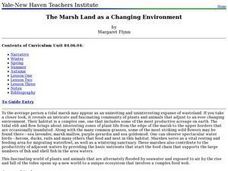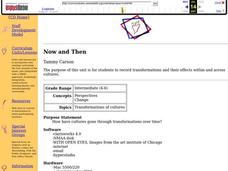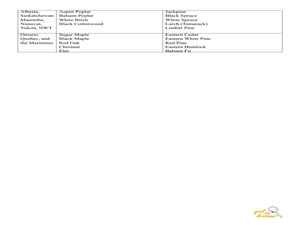Curated OER
Keeping Cool
Young scholars investigate the air conditioner units around the school. They chart the temperature by placing a thermometer in different situations and decide how to keep cool and save energy in the summer.
Henry Ford Museum
Physics, Technology and Engineering in Automobile Racing
Start your engines! This five-lesson unit introduces physics and Newton's laws through automobile racing. Each lesson includes background information, a student worksheet, and an answer key. There are also culminating project...
Brooklyn Children’s Museum
Rocks and Minerals in Our Lives
Young geologists discover the important role that rocks and minerals play in our everyday lives through this series of hands-on activities. Starting off with a lesson that defines the difference between plants, animals, and minerals,...
Henry Ford Museum
Sustainability: Environmental Management and Responsible Manufacturing
When you think about environmental sustainability, the Ford Motor Company probably isn't the first company to come to mind. A four-lesson unit introduces learners to the idea of sustainability and environmental stewardship. It describes...
Curated OER
Visit to Nature
Students complete a science journal which contains pages in which they can predict what they think they will see before the field trip, and also pages to write down what they actually do see during the field trip.
Curated OER
National Museum of Natural History
Students explore U.S. history by participating in a class field trip. In this museum instructional activity, students attend a field trip to the Natural History Museum and identify cultural stories and art pieces they enjoy. Students...
Curated OER
Cherokee Leaf Printing
Young scholars investigate their local creeks and forests and practice identifying trees. For this ecology identification lesson, students utilize a pad and pencil while on a field trip near their school and describe their trip while...
Curated OER
Joseph Andrews Quiz
In this online interactive reading comprehension activity, students respond to 15 multiple choice questions about Fielding's Joseph Andrews. Students may submit their answers to be scored.
Curated OER
ABC Community Walk
Students identify the different relationships that can be found in a community and create a class Community ABC Book. They participate in walking field trips to explore their community.
Curated OER
Learning About Maps
Students take a "field trip" with the teacher through the school then draw a diagram of what they saw. They bring the maps to the computer lab where they create electronic maps using the software program Neighborhood Map Machine.
Curated OER
Quad Squad
Students pretend they have visited a forest research station on an overnight field trip. They study forest fires, use compass directions, read maps, interpret imagery, and think about the impact of fire on ecosystems.
Curated OER
Food Webs in a Pond
Students explore food chains and food webs in a pond and identify common creatures found in ponds. They look for tadpoles, fish, mites and other creatures in a pond during a field trip for first hand research.
Curated OER
Art Through the Eyes of Youth
Students take a field trip to an art gallery reflecting on the paintings they like the most. Individually, they use magazines to find pictures related to their personality. In pairs, they make a mask to represent their ethnic group and...
Curated OER
The Marsh Land as a Changing Environment
Sixth graders continue their examination of the state of Connecticut. After taking a field trip, they identify the types of birds, plants, invertebrates and vertebrates who make their home in the salt marshes. In groups, they identify...
Curated OER
The Aquatic Environment
Fifth graders focus on the various types of fish living in different water environments. In groups, they research the different methods used to fish and participate in experiments to determine the effects of mercury on fish, the...
Curated OER
Long Island Sound
Students use the Internet to research the history of Long Island Sound. In groups, they identify the sources of point and nonpoint pollution and how humans are impacting the area. After watching a video, they discuss the role of...
Curated OER
Now and Then
Students record transformations and their effects within and across cultures. Students study the life of specific people in a former time period and then in the present time period. This teacher focused on the Winnebago tribe, using her...
Curated OER
Water-The Liquid Gold
Learners investigate the necessity of water for the survival of plants, animals, and people. They explore the affect that water has on human and natural environments through literature, field trips, and discussions.
Alabama Learning Exchange
Is it a Moth or a Butterfly?
Second graders examine the similarities and differences between moths and butterflies. They participate in a virtual field trip using a designated web site. They design a computer based slideshow using the information they find on the...
Curated OER
"Five Little Seeds"
Fourth graders complete various activities related to the plant life cycle. They read the book "The Tiny Seed," read and discuss the poem "Five Little Seeds," complete a "Plantenstein Mystery" and other online activities, write and...
Curated OER
Get to Know Trees
Young scholars recognize the characteristics of trees by using their five senses. In this trees instructional activity, students observe and record the characteristics of trees on a field trip. Young scholars then are blindfolded and...
Curated OER
Get- To Know Mammals
Students take a field trip and record information about mammals. In this mammals instructional activity, students hunt for tracks, waste, or other evidence that a mammal exists in this habitat. Students complete a worksheet on the...
Curated OER
Historical Scavenger Hunts
Students investigate the impact of historical events. In this historical scavenger hunt lesson, students examine photographs of a local monument that zoom in on details. Students record their impressions regarding the photos. Students...
Curated OER
Where are all the Animals?
Students view animals that camouflage at the Shedd aquarium website. In this camouflage lesson, students recognize that there are different types of camouflage, cryptic coloring, counter-shading, warning coloration and mimicry. Students...
Other popular searches
- Virtual Field Trips
- Free Virtual Field Trips
- Grocery Store Field Trip
- Math Virtual Field Trips
- Virtual Field Trips History
- Music Virtual Field Trips
- Farm Virtual Field Trips
- Business Virtual Field Trips
- Virtual Field Trips Lessons
- Aquarium Field Trip
- Field Trip to Historic Houses
- Health Virtual Field Trips

























